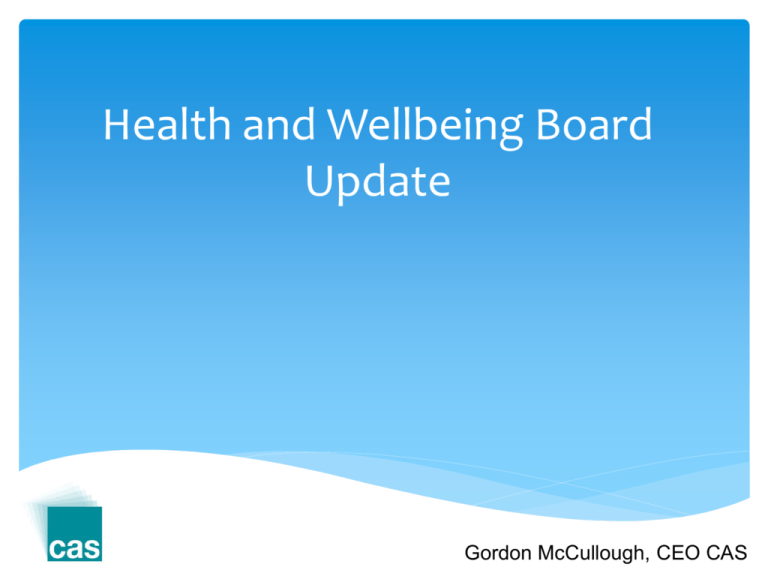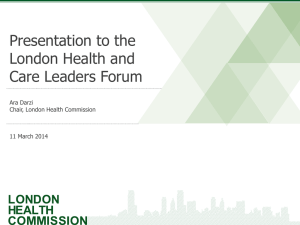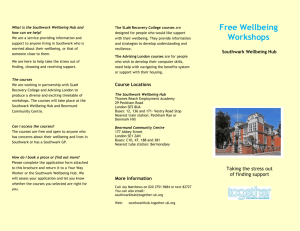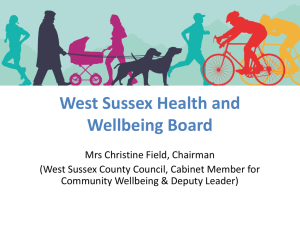Health and Wellbeing Board Update
advertisement

Health and Wellbeing Board Update Gordon McCullough, CEO CAS What is the aim of Health and Wellbeing Board? To determine the public health priorities for Southwark in the years ahead and bring a new shared approach to solving some of the public health problems which are too prevalent in our community. How? The intention is not to duplicate existing strategies • There are already key strategies for tackling the wider social determinants of health, promoting healthier lifestyles, improving health, educational and social care outcomes for children and young people, and delivering high quality health and social care for major causes of ill health and disability, including conditions associated with aging. • Influence actions and commissioning plans for HWB partners and providers • Joint Strategy Needs Assessment • Joint Health and Wellbeing Strategy • Adopts a ‘library bookcase’ approach to identify the key local strategies and examples of actions Membership • The Leader of Southwark Council • The Cabinet Member for Health and Adult Social Care • The Cabinet Member for Children’s Services • The Chief Executive of the Council • The Strategic Director of Children's and Adults’ Services • The Director of Public Health • Three representatives from the Clinical Commissioning Group • A representative of Southwark HealthWatch • A representative from King’s Health Partners • Southwark Borough Commander, Metropolitan Police Service • The Chief Executive of Community Action Southwark Four priorities for them to focus on: • Prevention and reduction of alcohol-related misuse • Coping skills, resilience and mental wellbeing • Early intervention and families • Healthy weight and exercise. Ways of working • • • • • • • There may need to be forums outside of the formal meetings for some discussions to take place – possibly through a planning group, similar to the one that was established to help set up the shadow HWB Members of the board will need to act as conduits back to their organisations. There needs to be two-way communication between the board and the various organisations represented on it. Board members should be free to express their differences but aim for consensus when making decisions. The board would like the NHS Commissioning Board (NHS CB) to be represented at meetings of the Southwark HWB Hold members to account over delivery of Joint HWB strategy It was agreed that the current membership of the HWB was about right, including the current political representation. Joint Health and Wellbeing Strategy There are three strategic objectives: • Tackle the root causes of ill health and wellbeing, improving the wider determinants of health and wellbeing, and reducing inequalities • Building resilience and enabling everyone, including the most vulnerable to manage their own health and wellbeing and to live healthy lives • Enable every child and young person to have the best start in life (Children and Young People’s Board). 5 Domains • An environment that promotes health and wellbeing • People make healthier choices and healthier lives • Preventing the need for more intensive health and social care • People have good mental health and wellbeing • Children and young people have the best start in life Joint Health and Wellbeing Strategy There are three strategic objectives which are: • Tackle the root causes of ill health and wellbeing, improving the wider determinants of health and wellbeing, and reducing inequalities • Building resilience and enabling everyone, including the most vulnerable to manage their own health and wellbeing and to live healthy lives • Enable every child and young person to have the best start in life. The third objective is moving forward at a faster pace than the others as the structures to deliver are in place already through the Children and Young People’s Board. Objective 1 is about tackling the root causes of ill-health, Objective 2 is about prevention and Objective 3 relates to the children and young people’s health. Joint Health and Wellbeing Strategy • Fast food • Gambling Engagement • To develop an engagement plan jointly with Community Action Southwark, HealthWatch and Community Development (Southwark Council) to support the further development of the strategy. This will be reported to the Board during the year to inform the development of the Health & Wellbeing Strategy (May 2013). • To identify and map local resources including social assets to develop a better shared understanding of the resource challenges and opportunities in the local system (Public Health & CAS December 2013) Southwark Clinical Commissioning Group The CCG will contribute to the delivery of the NHS Commissioning Board’s NHS Mandate from government. Through the delivery of our commissioning intentions and programme of service improvement the CCG will maintain and improve the following priority outcomes for our patients: • Preventing people from dying prematurely • Enhancing quality of life for people with long-term conditions • Helping people to recover from episodes of ill health or following injury • Ensuring that people have a positive experience of care • Treating and caring for people in a safe environment and protecting them from avoidable harm. • 3 local outcome indicators from current shortlist of 6 including: COPD and smoking, end of life care ; patients with LTC selfmanagement feeling supported and their quality of life; diabetes management and patients with asthma. Engagement with patients, members and partners is on-going to agree the final three Integrated Care Pilot Southwark and Lambeth Integrated Care. Integrated care offers an opportunity for the HWB as it focuses very much on prevention. It is about adult social care and health coming together. Changing the way work is done so that it is planned around the individual is at the core of this work. Key improvements to the system will focus on: • • • • Real-time information sharing, Changing the funding model, Shared governance and improvement Workforce changes. In particular the pilot will seek to improve early identification which will involve putting together a holistic health-check for elderly people to identify problems earlier down the line. This should reduce the need for more acute care. It will be necessary for all partners to work together collaboratively in order for this work to be successful. • Includes SLAM and 70% of GP practices have signed up







